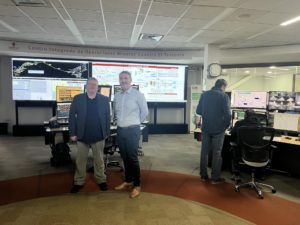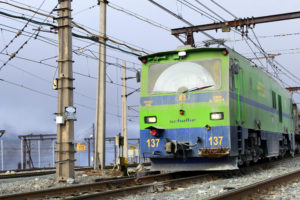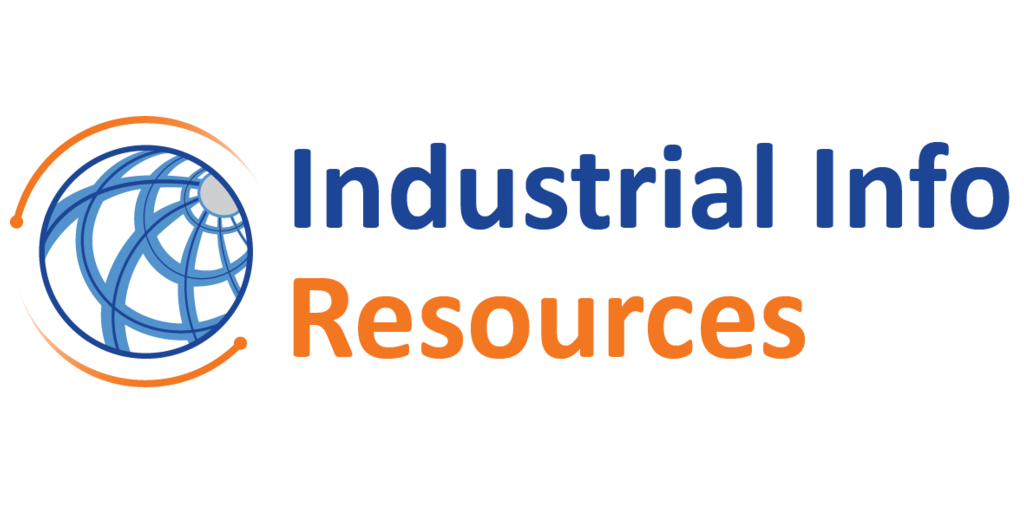Earlier this year, IM Editorial Director Paul Moore had a unique opportunity to tour Codelco’s Integrated Operations Centre or CIO in Rancagua, Chile which is the primary operations, control and monitoring centre for the El Teniente (The Lieutenant) copper mine, the world’s largest underground mining operation.
The CIO facility is located some 80 km away from the El Teniente mine that it monitors and controls, and first opened in 2015 – initially just for the mine production operations, with the concentrators being added in 2017. Finally in 2019, the crushing plants were added along with the hydraulic fracturing operations which are instrumental to the panel cave mine development. IM had the privilege of touring the facility with Pablo Olivares Jorquera, one of the CIO Managers for the El Teniente Division.
IM Editorial Director, Paul Moore with Pablo Olivares Jorquera, Codelco El Teniente CIO Manager

From a high level technology point of view, the CIO as with others within Codelco was developed by the Kairos JV between Codelco and Honeywell. El Teniente was the third Codelco operation to have remote operations capability after Los Andes and MMH, with all of Codelco’s mines now managed in this way. A big part of the Teniente CIO’s function is to analyse using advanced software, short-term strategies for the main transportation system to synchronise the productive chain in the most efficient way possible. This means connecting all the different mining sectors in El Teniente with the main transportation level, Teniente 8, to allow the mine to produce as much material as possible, managing blending of grades to the greatest extent possible and therefore maximising the ore processed in the mill.
The current main mine operations are the Sur Andes Pipa and Pipa Norte sections at 2,207 m plus the Diablo Regimiento, Reservas Norte, Pilar, Esmeralda and Dacita sections at 2,120 m. Apart from a small 15,000-20,000 t/d tonnage that goes to the Sewell plant, the vast majority of ore (130,000-150,000 t/d) reaches the Teniente 8 rail transport on the 1,984 m level bound for the Colon plant, some of which is crushed underground and some if coarse crushed on surface.
The big picture is the so called Integrated Mine-Mill Transportation Model underpins all the decisions being made in the Teniente CIO. This model is created at the start of every 8 hour shift and forecasts the mine performance for that shift including tying in with the fleet management system to predict all the loader movements that will take place for the various sections and how they can be coordinated best with the rail based ore transport system. This is crucial given that the main rail level is 7 km long with only one line ie no passing trains. The CIO has three main meetings when the mine status and plan are reviewed, which correspond with the 8 hour shift changes. Each shift has a report that summarises the mine performance in terms of efficiency and tonnes produced.
On the ground in the mine itself, the loaders carry most of the material throughout the mine, many of which are autonomous. To give some idea of how long the mine has been using loader digitalisation and autonomy – Sandvik AutoMine-equipped LHDs began operation at Pipa Norte way back in 2004 – though of course AutoMine has gone through many, many improvements, iterations and versions since then. But it illustrates El Teniente as a true pioneer in underground autonomy, and AutoMine remains the dominant equipment automation system in use in the mine and therefore has the most controllers and operators in the CIO.
Sandvik AutoMine has evolved together with the mine since it was first used with loaders at Pipa Norte back in 2004

The scope of the CIO is growing all the time as El Teniente is already in a major expansion phase via the new Recursos Norte section on the current mainly used 2,120 m main level which is already in production as well as the additional Diamante and Andesita projects which are below the 1,984 m transport on an intermediate 1,900 m mine level and Andes Norte on an all new mine 1,700 m level, all of which are in advanced construction and will extend El Teniente’s mine life by at least 50 years – progress execution works for the Andes Norte, Diamante and Andesita projects as of June 30 stood at 79.6%, 29.2%, and 30.1%. These sections are to maintain current levels of production mainly, as the grade of copper ore in the existing workings is declining. The big difference with the new mine level is that it will use conveyor belts to haul ore out of the mine as opposed to the Teniente 8 railway.
Jorquera told IM: “The purpose of the CIO is to take charge of the complete operations of the mine, functioning almost like an orchestra with different sections right from fracturing through to tailings. Everything you see here in the CIO was before being done in the mine or at least at the minesite. It is possible to operate the mine almost completely remotely from here, with major exceptions of course being maintenance related tasks and the machines not yet automated. But for added redundancy such as the case of a cut in communications due to an earthquake or power blackout, we also still have the capability to run the mine independently of the CIO as well.” The CIO is connected to the mine via optic fibre cable as well as satellite-based comms.
One autonomous equipment operator can control and monitor up to five loaders from one station in the CIO. The same applies to trucks and to rockbreakers. But due to the mine size and complexity – it is essentially several different mines in one complex – plus the different ages of equipment and the requirement for support and utility units, El Teniente remains a mix of fully autonomous, teleremote and conventionally operated machines. And there is a mix of primary equipment – the mine having a lot of Sandvik equipment as mentioned but also Caterpillar and Epiroc machines.
Jorquera adds: “We have a lot of interaction of machines – for example loaders and trucks – from different OEMs. This is just due to the fact that some machines have been selected for their size or suitability for certain tasks in different sections, but also relates to different machine availabilities and lead times over the years, for example.” Diablo Regimiento also has the distinction of the location of the mine’s first all battery electric primary machine, an ST14 SG from Epiroc, which remains in testing. El Teniente also has experience of hybrid machines, having operated a Komatsu 18HD loader that utilised an SR drive. The operation has also used Fambition LHDs from China.
Also, automation has not evolved at the same pace for all machines – good examples being ground support, utility or explosives delivery equipment – so again, as these machines become more available with more autonomy, then more of these operator tasks can be moved to the CIO. For the new Andes Norte, Diamante and Andesita projects one they enter production it will be much easier to implement more autonomy from the outset as they will effectively be new mines within the mine. Their crushing plants located underground are already being used during development and are being remotely controlled from the CIO.
The Andes Norte project will soon enter production – one of a series of new mining sectors at El Teniente

Jorquera continues: “Reactivity is one of the big advantages of the CIO – we can take instant decisions. For example comms between the operators of the ore train management system and the operators of the crushing and ore chute systems are now pretty much real time – as opposed to replying on radio comms underground.”
Achieving Railway 8’s automation potential
El Teniente has in theory had autonomous capable ore trains for many years but only recently have they been operated fully autonomously. In fact, in April not long before the IM visit, thanks to the recovery and updating of the functionalities of the signalling and traffic control system (known as Interflow) of the Teniente 8 Railway, which carries a large part of the production from inside the mine to the surface processing plants, success autonomous rail transport tests were conducted. Building on work that began in 2021, one of the ten production locomotives was able to move autonomously with instructions sent from CIO in Rancagua, to the mine more than 80 kilometres away, a big relevant milestone towards the planned operation of trains without drivers by 2025. These tests seek to recover the ATO (Automatic Train Operation) mode of the locomotives, which is what allows the train to move autonomously. Due to operational difficulties at the time of first delivery over 20 years ago, the system fell into disuse and became obsolete.
El Teniente’s locos are finally beginning to achieve their autonomous potential

The process is as follows – material extracted among the different mine sectors is taken to the main ore passes feeding the transport level. When an ore pass has enough material to fill a train (1,500 t) a trip is declared to the main transportation team in the CIO. Trains pick up the ore produced from the ore pass inside the mine and carry on to the dumping zone outside the mine, with a return trip taking about 1.5 hours including loading and dumping. The main transportation has eight trains operating simultaneously, two of them being exclusively for fine mineral crushed inside the mine and the other six for coarse mineral crushed outside the mine. An average shift has 8 hours where it can perform up to 40 train laps in total.
Inside the CIO – a natural flow
Broadly the CIO is divided into two main sections – the first dealing with the mine, and the second dealing with the rail system, the plant and the roads in and around the surface operations. Similarly to other IROC facilities, there is also in the centre of the room a central screen with an overall view of the whole operation from mine to plant. In the centre of the mining section there is also a dispatch controller monitoring the fleet management system for the operation including the machines that are working, those that are in maintenance, the loads being carried etc. Clearly a big plus with the CIO is that operators are not having to travel two hours to the mine, which has a sustainability element too as they would normally go by bus, though El Teniente has introduced a large fleet of battery electric buses in recent years.
But what is distinctive about the Teniente CIO is that the majority of operators of autonomous equipment have originally worked in the mine itself so they have a deep understanding of the mine layout and equipment. And this is still the preference, for the most experienced operators to pass from the mine operations into the CIO, where possible. Of course they also receive autonomous system training, in the case of AutoMine from Sandvik itself as the supplier.
The El Teniente CIO operators are highly experienced

Within the mine section, first up is the load and haul area, which includes the ore pass rockbreakers, in the first bank of operator stations at one end of the large room; then the underground crushing operations in the next row after that. The load and haul stations are dominated by Sandvik AutoMine LHD chairs, as Sandvik loaders represent by far the largest proportion of autonomous equipment running in the mine.
And this close partnership continues – in January 2022, Sandvik received a major order for more AutoMine load and haul systems valued at about SEK 250 million or $28 million from Chile’s Codelco to be used in the El Teniente mine, specifically to run at the new Andes Norte block cave to 2027. In addition, a connected load and haul equipment order, with an initial value of SEK 150 million, was received, bringing the total value of the orders to SEK 400 million. The new order will be supplied in two phases. During 2022 and 2023, Codelco has received two Toro™ TH663i trucks and two Sandvik LH514 loaders, as well as an AutoMine Fleet system capable of being scaled to support up to 16 machines and AutoMine production area hardware for future expansions over several years.
Plus, Sandvik has delivered AutoMine Fleet and 13 LH514 autonomous loaders for the Recursos Norte section, again with a deal running to 2027 and being delivered in two phases. A new fleet of fleet of Sandvik LH517i 17 t and Sandvik LH621i 21 t loaders is also running with AutoMine. And AutoMine is also being deployed on Sandvik underground trucks at the operation. Trucks are mainly used on the Level 6 (2,163 m) and Level 7 (2,070 m) levels, with the vast majority of other ore transport (apart from final rail haulage) being LHD direct to crusher or ore pass.
During IM’s visit there were some Caterpillar Command for underground chairs being prepared for operation – this system was validated at the mine during 2016-2018 and now Caterpillar R3000H loaders are set to be introduced to El Teniente and operated autonomously, with a large fleet also being deployed to Codelco’s newer underground operation at Chuquicamata.
But having a more mixed autonomous fleet will be challenging – the mine is working closely with long term OEM-agnostic partner RCT to ensure this can be carried out seamlessly as all these new systems begin to interact – the companies have already worked together for a number of years using RCT ControlMaster Automation for various tasks.
Moving on to the underground crushing, this is all done inside the mine and controlled and monitored from the CIO, with one large primary gyratory on level 2,163 and another on level 2,070 m plus a series of other secondary underground jaw and cone crushers on other levels. The CIO has the ability to some extent to manage the route of the material depending on the fragmentation coming out of particular drawpoints. The ore route also depends to some extent on the grade, with the lower levels in general having a higher grade – up to around 1.4 to 1.5% copper, with upper levels as low as 0.8% copper.
The five primary crushers again are from different OEMs – as an example the newest Dacita section machine at 2,070 m is a thyssenkrupp 54-75 gyratory model delivered in 2013 and the older main primary gyratory crusher on 2,163 m an Allis Chalmers 54-74. Going forward, Metso has the contract to deliver a large new Superior MKIII primary gyratory and associated apron feeders for the Andes Norte operation on the new 1,700 m level. Diablo Regimiento also has three large primary jaw crushers in operation underground. But not all crushing is done inside the mine – broadly the underground crushers handle finer material and crushers outside the mine coarser material – again with this divergence being possible due to the ability to route loaders to the appropriate production routes and ore passes.
Then the natural order of the CIO moves from the crusher operator stations to the underground railway operators including the Teniente 5 railway that transports material to the Sewell plant and the main Teniente 8 railways that transports the majority of the mine production to the Colon plant. As with the autonomous loader operators, the staff controlling the railway management are highly experienced from having worked with the same systems at the minesite. These stations monitor the trains not just inside the mine but as they emerge to surface.
Then moving to the other side of the CIO brings you into the primary and secondary crushing monitoring area for the comminution that takes outside the plant (for coarser material not crushed underground) – followed by monitoring and operating stations for the plant milling circuits where the SAG mills receive the ore from the mine at both the Sewell and Colon plants followed by secondary ball mills. Then next door to this is the flotation monitoring area including froth cameras, with the flotation recovery being in the region of 87%. The plants themselves onsite still have monitoring stations similar to those at the CIO, but the CIO is now the primary control room with the onsite room acting as a back up facility. Also in this area is a security focused section, with feeds from over 1,000 high resolution cameras situated throughout the mine and plant as well as the route to the plant. Workers both above and below ground also carry tags based so their location can be monitored in case of emergencies, with safety paramount in the mine operations.
There is also an area dedicated to maintenance and logistics, including traffic and road systems as well as transport of concentrates from the Sewell and Colon concentrators to the Caletones copper smelter operations. Ultimately the plan is to also have the whole Caletones operation controlled fron the Rancagua CIO as well but this is transfer process is still ongoing. Other stations deal with water resources, including recycling.
Tailings dam monitoring is next, with the Caren tailings dam that serves El Teniente being located in the municipality of Alhué. The dam has been in operation since 1986 and recently completed a seventh stage of expansion – raising the height of the reservoir’s earth wall by 62 m, from 175 to 237 m. It was also reinforced by 32 m, from elevation 128 to elevation 160. Tailings are transported some 89 km via a concrete canal, including many tunnels to the Caren TSF. The CIO monitors all the sensors for the dam and can issue rapid evacuation warnings in the event of any detected problems or movement.




